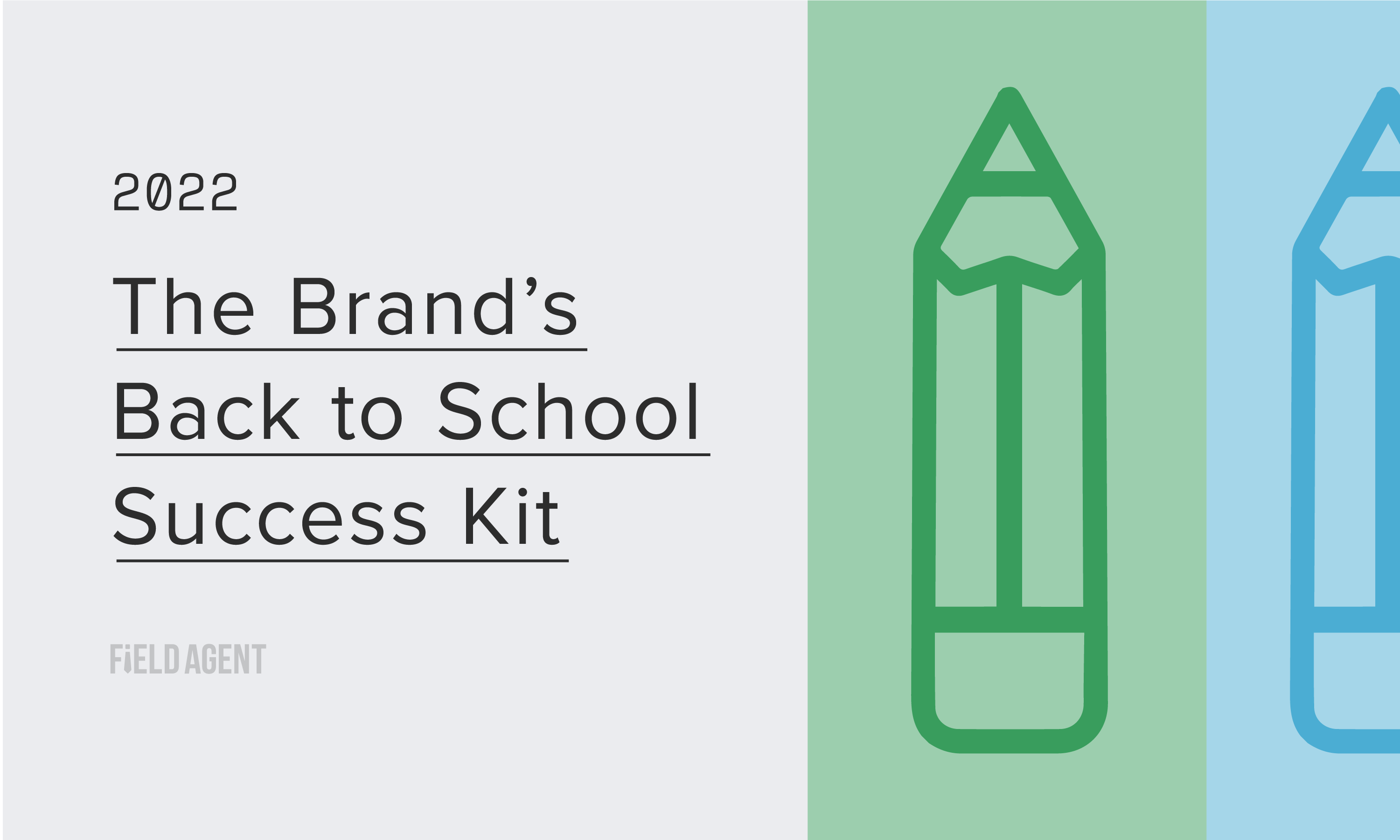
The Back to School Success Kit: How Brands Win BTS Shoppers, Sales
For many retailers and brands the BTS shopping season is a make or break time of year and getting it right is critical. Here at Field Agent we wanted to dig deeper and provide some insights on how you can make the most of this selling opportunity.
Field Agent recently conducted a survey of 771 Canadian households with kids entering K-12, everyone—100%—said they’d make at least one purchase for the upcoming school year.
Just look at the chart. 9-in-10 households said they expect to purchase basic school supplies, clothes, and footwear for the approaching school year.
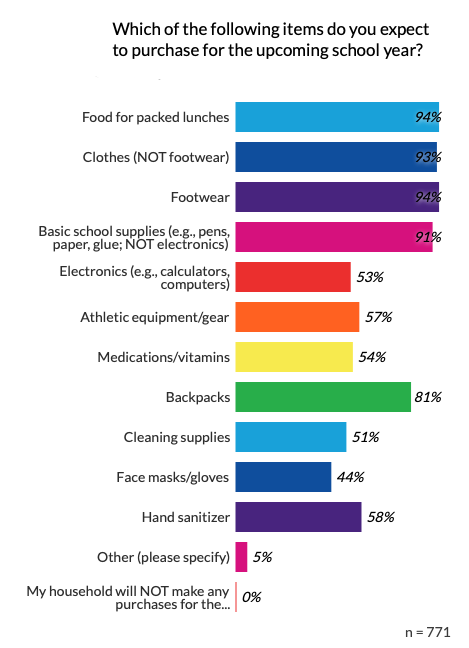
*All survey respondents were Canadian adults at least 18 years of age, smartphone owners, and mothers of children entering K-12 for the 2022-23 school year. The survey was executed through the Field Agent platform, June 1-14, 2022.
In other words, if you’ve got kids, you’ve got BTS purchases to make. With few exceptions. This, alone, makes BTS an enormous shopping event - and a major opportunity for companies.
In the words of one sales executive for a major school-supply brand, who was interviewed for this article...
“[BTS] supply shopping is unique. There really are no other shopping occasions throughout the year where so many households are required to buy so many of the same items at the same time!”
All that to say: BTS is a red-letter, make-or-break event for many brands, and the stakes are higher than a senior-year calculus exam. So, what exactly can brands do to make the grade with shoppers this year — and grow those all-important BTS sales?
Below you’ll find survey data, a BTS checklist, recommended tools, and 20 insider tips to help your brand make the most of the coming BTS shopping season.
School’s now in session. For all of us.
Get the 2022 Back-to-School Checklist for Brands
BTS Success: 20 Tips to Help Brands Grow Their Back-to-School Sales
#1 - Know (and follow) the retail success formula
Inventory + Space + Execution = Retail Success.
Regardless of the shopping event, BTS or otherwise, high-performance brands know the trifecta of inventory, space, and execution will carry the day.
- Inventory - Because you can’t sell what isn’t there
- Space - Because more space (e.g., on-shelf, in displays) means closer proximity to purchase-ready shoppers
- Execution - Because retail plans rarely go, well, according to plan
Leading up to and during the BTS season, filter your decisions through the retail success formula. “Will this [fill in the blank] help us get and keep sufficient stock on-shelf, earn more space next year, and/or ensure accuracy and compliance at the store-level?”
If yes, there's a good chance you'll positively impact BTS sales.
But note that the retail success formula cuts across two phases of the BTS-retail calendar: the sales phase (which occurs well before and leading up to BTS shopping) and the execution phase (which transpires while BTS shoppers are making purchases).
Think of it this way: “This year” is an opportunity to win not just this year – but next year as well.
Consider inventory, for instance.
Inventory should be top-of-mind for brands not only during the BTS execution phase (e.g., making sure shelves are restocked while BTS shoppers are in stores) but also during the BTS sales phase (e.g., convincing retail partners to buy more).
So stay mindful of the retail success formula this BTS season – and its implications not only for BTS success this year, but BTS for years to come.
#2 - Execute. Execute. Execute.
But what if you’re already in the midst of a frantic BTS shopping season? Is there anything you can do now to impact BTS sales?
Yes. As you’ll read, most of it has to do with execution – ensuring your real-world, retail operations are going off without a hitch, and that retail partners, fieldworkers, and the like are in compliance with established agreements.
Effective BTS execution may assume many forms, from pricing compliance to on-shelf availability. And since it may be difficult to cover all the bases, Field Agent created this Back-to-School Success Checklist to help you with your BTS-retail execution.
To execute well, a brand must monitor well. And monitoring is at its best when it's...
- Proactive - Preventing problems at-retail; not just fixing problems
- Systematic - Planned, structured, organized, and measured
A retail auditing program, as described here, is a proven way to improve retail sales.
And BTS retail is no exception.
#3 - “It’s about product availability, Stupid”
It’s a favourite saying in political circles: “It’s the economy, Stupid.”
But what the economy is to winning and staying elected, product availability is to winning and keeping BTS customers. Especially today, in an environment of hyper-uncertainty about the supply chain.
Years of Field Agent research into BTS shoppers have made this abundantly clear: Shoppers hate, loathe, and abominate out of stocks. Especially during the mad dash of the BTS season.
Field Agent asked 771 Moms with K-12 children to identify the single biggest obstacle when shopping for BTS purchases inside stores. With inflation soaring, obviously affordability is top-of-mind, but the second biggest obstacle to BTS shopping identified by Moms was “product availability” – making it an important issue for retailers and brands to address over the next few months.
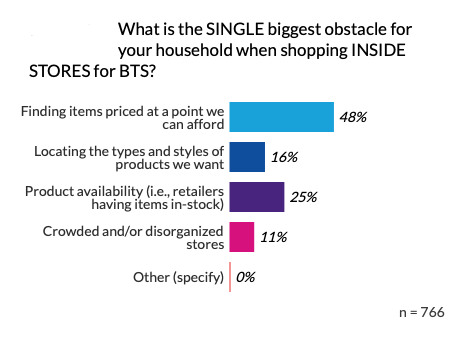
We also asked these moms to tell us in their own words what, more than anything else, is top of mind as they enter the coming BTS shopping season.
Many said they were dreading out of stocks:
- “I believe it will be more stressful than ever because I do not think stores will have sufficient stock.”
- “I'm worried there will not be much of a selection as stores already struggle to keep items stocked.”
- “Top on my mind…is finding the items in-stock that my son can get excited about."
And here’s a high-stakes question: What happens if your brand isn't available for purchase when BTS shoppers hit stores? Here, too, we asked BTS shoppers. Exactly half (50%) said they would generally purchase a different brand at the same retailer.
Not being in-stock is like inviting shoppers to try a rival brand.
Moral of the story? Keep a constant eye on stock levels throughout the BTS season – both in-store and online.
And also…
#4 - Micromanage the supply chain
Of course, for brands, product availability isn’t completely controllable.
With the supply chain in disarray, a brand can only do so much to ensure SKUs are in-stock and available for purchase.
But, brands can do some things – and what they can do, they should do.
In Field Agent’s holiday report, we quoted a knowledgeable CPG executive as follows:
“Hyper focus on your supply chain, and micromanage inventory, orders, and forecasts at every step in the supply chain. The global supply chain is so tangled and disrupted that those who are paying the closest attention and driving the highest urgency are the ones that will outperform.”
What was great advice for the holidays, remains great advice for the coming BTS shopping season.
In an environment of such extreme supply-chain complexity, brands that are attending to the controllable parts of the process will gain market share from their hands-off competitors.
#5 - Beware phantom inventory – Bwahaha [thunder clap]
Phantom Inventory occurs whenever a retailer's inventory system shows stock that, due to shrink, damage, supply chain issues, etc., isn't actually available for purchase. And it’s a problem for brands.
You may think your brand is comfortably in-stock, but inventory information and inventory realities don’t always agree.
And during the BTS shopping season, you can’t leave anything to doubt – especially not product availability.
Be vigilant against the phantoms out there.
#6 - The price has to be right
Amid record-high inflation, BTS shoppers will be more price-conscious than ever.
A sales executive with a major school-supply brand put it this way:
"This year the shopper will be even more focused on finding the best deals and promotions – it is absolutely critical that retailers make their shoppers aware of their back to school offering and get credit for promotional efforts."
Based on our survey of over 771 BTS moms, “finding a price point that we can afford” rivals product availability for the top obstacle among BTS shoppers.
Price matters. More than ever.
In our free-form question, moms were especially vocal about price concerns entering the BTS season, with one Mom stating: "With cost of life these days everything is about how much we spend and save".
And it’s not just prices brands need to watch, but price tags.
BTS is already pandemonium – with crowds, lines, out of stocks, disorganized shelves, and so on. Now throw in steadily rising prices and labor shortages, and we’re talking about a perfect storm of retail conditions in which mistakes and oversights will flourish.
Including missing and incorrect price tags.
You might consider auditing those price tags leading up to and during BTS.
#7 - Help your buyer win
As discussed in our ebook, The Buyer Meeting Success Kit, brands succeed by helping their buyers succeed. And while this could take many forms, for now lets emphasize the importance of partnering with your buyer around one goal: growing the category.
If you can position yourself as a category expert, you’ll become much more than another “one-hour time slot” for your buyer. You’ll become a partner and a resource. While you can’t give gifts to buyers, you can always give the "gift" of data and expertise.
So this BTS season…
- Collect data and photos of what’s happening in your category
- Understand BTS shoppers and their category-specific behaviors, attitudes, and pain points
- Explore how other retailers are executing the category
And share, share, share with your buyer.
That’s one powerful way to help your buyer win, and to build trust that could last for BTS seasons to come.
#8 - Focus on strategically-imperative retailers
We’ve mentioned the importance of inventory, space, and execution. We’ve also mentioned the need to stay on top of stock levels, prices and price tags, and even buyer relations.
You’re probably thinking: There’s not enough hours in the day.
You’re right; there isn’t.
So, we encourage you to identify one to a few strategically-imperative retailers on which to focus your efforts this BTS season, during both the sales and execution phase.
Maybe it’s a retailer (or two) with plenty of unrealized potential, or maybe it’s a retailer where your brand is already on a growth trajectory but you can grow faster.
Pick one (or a few) and go all-in there.
But you may be wondering which retailers are most popular for BTS purchases?
For basic school supplies, there is one juggernaut, and two close runners-up. We asked 767 K-12 moms to identify all the stores (i.e., brick-and-mortar retailers) from which they’ll buy school supplies during the approaching BTS shopping season.
89% in our survey said Walmart, 69% said Dollarama and 67% chose Costco. Then there’s a significant drop-off, with Staples, Shoppers Drug Mart/Pharmaprix and Dollar Tree in spots three through five, respectively.
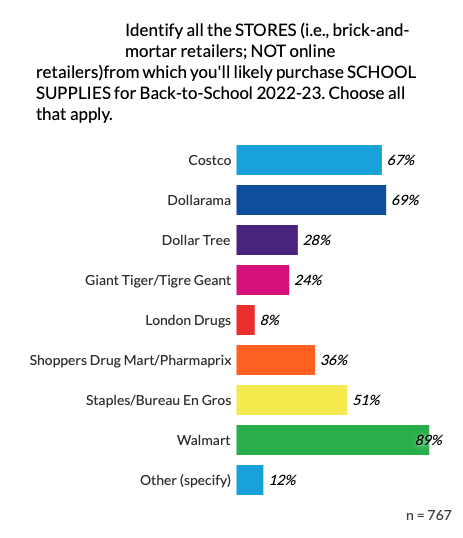
But what about online purchases of school supplies? Amazon is at the top of the class for BTS sales.
Of 605 K-12 households who expect to buy school supplies online, 84% said they'll make online BTS purchases from Amazon, compared to 42% at Walmart and 36% at Staples.
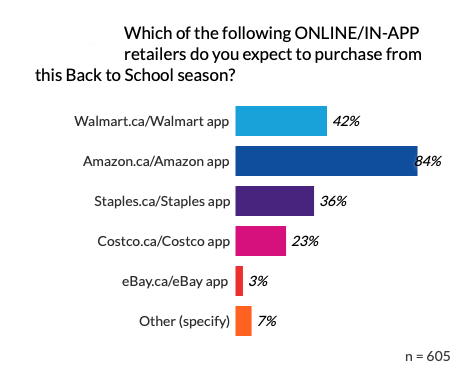
Of course, BTS isn’t just about the school supplies, it’s also about the groceries, clothes, and much more.
Consider groceries, for instance. 94% of moms surveyed said they’ll at least occasionally pack a lunch for their kids when they head off to school. Among these households, the top retailers for school-day groceries were:
- Walmart (70% said they’ll buy groceries from the retail to pack lunches for their kids)
- Real Canadian Superstore (67%)
- Costco (66%)
- No Frills / Maxi (45%)
#9 - Win July to August
August has always been - and probably always will be - the critical month for brands and retailers looking to win BTS dollars.
“The first two weeks of August are big weeks,” said the sales executive interviewed for this article. "
However, with supply chain disruptions, inflation, and higher than normal out-of-stock levels, many K-12 moms told us they’re planning to shop BTS a little earlier than years past.
In our survey of 768 K-12 household 29% said they plan to shop earlier for BTS this year than they did last year.
But the timing of BTS purchases doesn’t happen in a vacuum. They’re dependent on things like the release of school-furnished supply lists, sales and coupons, etc.
In a climate of higher prices and widespread out of stocks, we expect shoppers to start their BTS shopping earlier, but this isn’t to suggest they’ll finish their BTS shopping earlier.
Expect the July to August time frame to be critical for brands and their BTS performance.
Get the 2022 Back-to-School Checklist for Brands
#12 - Rethink what a BTS purchase is
What exactly is a BTS purchase? (We looked in the dictionary; no luck.)
In our survey of BTS moms, we gave respondents the option to write-in BTS purchases they'd make that weren't listed among the choice options we provided. It was interesting to see some of the write-ins, for instance:
- Personalized name labels
- Glasses and Eye Contacts
- Skin Care
- Hair accessories
58% in our survey of 771 K-12 households said they expect to buy hand sanitizer for BTS, while 51% expect to buy cleaning supplies like disinfectant wipes.
In other words, BTS purchases extend well beyond supplies, attire, and groceries.
Additionally, consider now that many of these under-the-radar BTS purchases may require yet more purchases of complementary items.
Makeup may require a makeup bag; eye contacts may require cleaning solution.
And while this is good news for many brands, it also means shoppers have a lot of demands on their BTS dollars. A lot.
Meaning brands have to bring their A-game.
Be early. Be available. Be visible.
#13 - Think omnichannel. Seriously.
Get this.
In our survey of 768 K-12 households that plan to make BTS purchases:
- 99% said they expect to purchase school supplies in-store
- 80% said they expect to purchase school supplies online
And that’s just school supplies.
Altogether, 95% of these households said they’re at least moderately likely to buy clothes and/or footwear during the approaching BTS shopping season.
Of these (n = 768), a whopping 73% said they’re at least moderately likely to make such purchases online. 13% said they’re completely likely.
Taken together, what does all this mean for brands?
BTS, especially today, with supply chain disruptions, out of stocks, inflation, and pandemics, isn’t stores or websites or apps. It’s all of them.
So, you need a strong omnichannel game for these omnichannel shoppers.
Back to school shopping isn’t one-and-done. Shoppers today are willing—sometimes forced—to spread their purchases over more than one retailer, over more than one channel.
#14 - Pick it up on store pickup
Let's get philosophical again. What is an online BTS purchase?
Such purchases don’t always end with a package delivery to a front doorstep. Increasingly, online purchases culminate in a trip to a B&M store, where even more purchases may transpire.
We asked 606 K-12 households, all being at least moderately likely to make online purchases of school supplies this BTS season, to identify which services—store pickup, local delivery from a store—they’re at least moderately likely to use.
- 48% said they’re at least moderately likely to use in-store or curbside pickup when purchasing BTS school supplies
- 33% – in-town delivery from a local store
What this means is, online doesn’t necessarily mean online, in the purest sense. It also means brands must be prepared for pickup purchases.
You might be thinking, “How do you prepare for pickup purchases? Don’t they just happen?”
More times than you might realize, SKUs that are available in-store aren’t actually listed for online purchase (or store pickup).
Then there’s the whole matter of making sure you’re in-stock online (not just in-store), which is another crucial, oft-overlooked consideration. After all, SKUs necessarily run out of stock faster online – that is, at stores with OPD operations.
As more BTS purchases move online and to OPD, brands should invest the time, money, and energy to ensure their OPD execution isn’t hemorrhaging sales – but adding to them.
#15 - Whip those ecommerce pages into shape
If more and more BTS purchases are occurring online, it stands to reason that brands should take a hard look at their product-detail pages (i.e., product/item pages) on ecomm platforms like Amazon and Walmart.ca. Are they winning BTS sales…or losing them?
Our colleagues in the US published an ebook, How to Build Ecommerce Product Pages that Win Sales, which offers tips like:
- Picture your way to more sales
- Carefully balance SEO and engagement
- Get “romantic” in the description
- More isn’t always better
Here, too, your brand probably wont be able to radically optimize your product pages for every ecomm platform out there. So you may need to identify some strategically-imperative platforms where you’re determined to move the needle this BTS season.
#16 - Be proactive about online ratings and reviews
Speaking of product-detail pages, do you have enough ratings and reviews to greet BTS shoppers when they arrive on them?
In a previous Field Agent survey of 1,640 shoppers who make an online purchase every month on average, 9-in-10 respondents said they regularly read product reviews to guide their online purchases.
By category, here’s the number of online shoppers who said they “always” or “often” look at ratings/reviews prior to making online purchases:
- Electronics: 79% (always or often look at customer reviews)
- Attire: 69%
- Household consumables: 35%
- Groceries: 21%
Moreover, 93%, 91%, 64%, and 45%, respectively, at least “sometimes” read product reviews before buying online.
All that to say, brands need sufficient numbers of recent reviews on their product pages.
Not just because ratings and reviews are influential over BTS shoppers, though they are, but because ratings and reviews are an important determinant of content quality scores—which influence how high a brand ranks on a retailer’s product-listings page.
#17 - Shift your ad spend
Out of stocks can be rampant—in-store and online—during the BTS shopping bonanza. So, here’s a question…
Why spend ad dollars when and where you’re out of stock? That’s just a waste of money.
Keep track of where you’re in-stock, and spend your ad budget there.
Moreover, keep track of where your competitors are low or out of stock, and use your ad spend to intercept some of their sales.
And remember, many online retailers will penalize you for being out of stock. So why subsidize retailers to charge you fees by advertising where you’re not in-stock?
We’re talking double-whammy.
#18 - But, by all means, stay focused on brick-and-mortar
That’s a lot of talk about ecommerce – and for good reason.
But brick-and-mortar is still king when it comes to BTS.
As seen every household (100%; n = 768 K-12 households that plan to make BTS purchases) said they expect to shop for school supplies inside stores this BTS season.
And not just one store either. Take a look at the chart below. 59% expect to spread their in-store school-supply purchases over at least two B&M stores.
Twenty-five percent anticipate buying school supplies at four or more stores. Whoa.
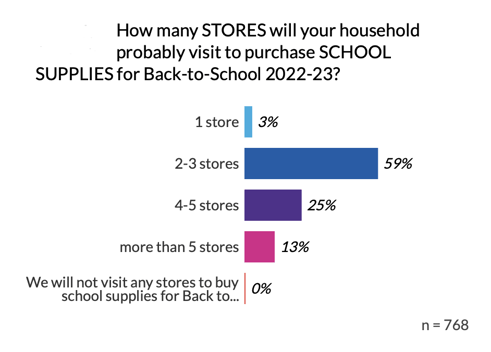
B&M is still where BTS mostly happens. And not just because of sales, tax-free shopping, and other price-driven considerations.
But also because, as our research through the years suggests, there may be a ritualistic component to BTS shopping. It’s something many families do together – as an annual activity, as a rite of passage, and as a way to get kids excited about the coming school year.
#19 - Grease the way for new products
BTS is a time when many brands and retailers roll out new products.
We've written about it in-detail elsewhere, but new products always start from behind. For many reasons:
- Shoppers are often comfortable with their established purchasing patterns and loyalties
- New products are unknown and, thus, more risky for shoppers to purchase
- New products have little opportunity to build up critical social proof, including word-of-mouth and online reviews
- Retailers favor known winners
- Shoppers can’t buy products if they don’t know they exist
And all of this makes new products particularly vulnerable.
So brands should think twice about turning over their new products completely to the whims of shoppers and retail partners. Instead, brands should consider greasing the way for those new products to succeed.
And speaking of new: New marketing solutions are available that start with guaranteed sales, rather than follow with potential sales. For instance, consider ratings and reviews, and/or buy-and-tries for your new products this BTS season.
#20 - Have a strong “after” strategy
BTS success isn’t just about what happens before and as shoppers are making purchases.
It’s about what happens after, too.
For instance…
- Did your brand negotiate advantageous terms for any seasonal inventory that didn’t sell? And did your brand collect data and photos during the BTS season to aid these negotiations for next year?
- If applicable, are you prepared to efficiently and effectively recall unsold units—as well as expired promotional materials—from inside stores?
- Are you familiar with the new, post-BTS conditions inside stores after certain categories reset? It might be beneficial to do a planogram-reset audit.
Being strategic and purposeful about what happens after BTS can set your brand up for successful negotiations with retail buyers.
And give you a head start on BTS success for years to come.
Make the Grade with Back to School Shoppers
The right tools make all the difference. In life and in retail.
Field Agent offers a variety of fast, simple, affordable tools to help brands win BTS shoppers and sales. From auditing to marketing, merchandising to ecommerce, Field Agent is your brand’s one-stop destination for BTS success.



